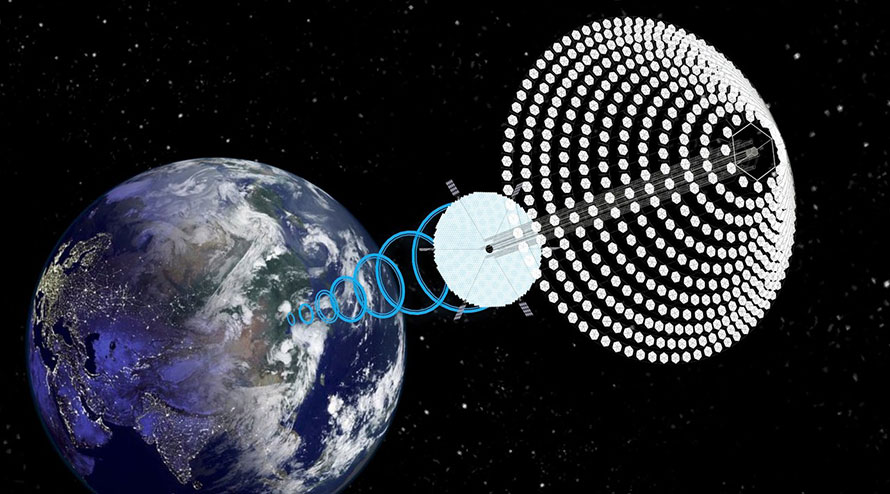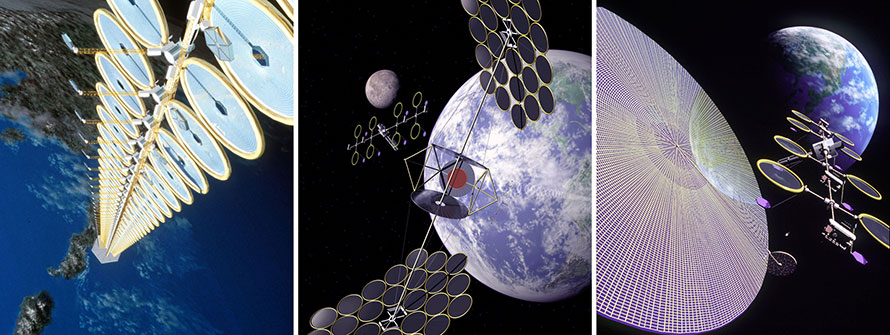Establishment of an operational space-based solar power system harvesting solar energy in space and transmitting that energy to markets on Earth.
 SPS Alpha. Image: John Mankins, Mankins Space Technology
SPS Alpha. Image: John Mankins, Mankins Space Technology
DESCRIPTION
Space solar power (SSP) can potentially supply a majority of the electrical needs of our planet. SSP would transmit from orbit energy from the Sun that promises to be clean, reliable and affordable. Most significantly, it would be renewable and inexhaustible.
Many of the world’s greatest problems will be greatly alleviated by accessible energy, cheap energy, or both, which can be provided by SSP. Unlike Earth-based solar power, SSP can provide almost continuous baseload as well as peak load power to replace fossil fuels. It can light and heat homes, power factories, be used for farming, for transportation, for desalination of seawater, and to provide energy in remote areas.
SSP can reduce or eliminate the need to burn fossil and nuclear fuels to generate baseload electricity. Baseload use alone currently represents about one-third of all the world’s energy demands. The capacity of SSP is so large that it should have an immense effect in reducing production of greenhouse gases and their effect on global climate.
As an initial system is augmented and improved, increasing percentages of terrestrial baseload power may be supplied from space. Even before an SSP system is completed, the realization of the pending availability of so much energy could promote world peace by substantially reducing the need for nations to compete for control of fossil fuels.
A major economic and practical advantage of SSP for baseload power utilities is that it requires almost zero energy storage, because sunlight is continuously available in space in a geostationary or geosynchronous Earth orbit (GEO or GSO). SSP platforms located in GEO could provide power to receivers on Earth more than 99.5% of the time. Ground based intermittent alternatives such as solar and wind cannot be used directly for baseload power (the minimum amount of electrical power needed during any 24-hour period), since that would require massive amounts of expensive energy storage. Large amounts of the solar and wind energy currently produced is being wasted when there is an excess of production, due to a lack of energy storage facilities. Since SSP is not intermittent, it can be used directly as baseload power, with only minimal energy storage (during periods when each platform is briefly in Earth’s shadow) and therefore does not require significant local storage. Baseload power is used at a relatively constant level, and accounts for about two-thirds of the total amount of electrical energy needed globally. By avoiding expensive storage technologies, SSP is projected to be much cheaper to produce for baseload power than clean ground based energy alternatives.
An SSP system would primarily be used to provide continuous baseload power, notwithstanding night or weather conditions, but some of the power can be used for intermittent or emergency use as needed, partly due to its ability to be redirected from one receiver to another in less than a few seconds.
Multiple locations, even isolated settlements, could increasingly be served by SSP – reducing the need for expensive, delicate, and politically sensitive long-distance re-transmission networks between power plants and the places of end use. SSP would also greatly reduce the need for fossil fuel delivery systems (such as pipelines, tanker ships, trains and trucks).
Space solar power for baseload power markets should be much more economical in its use of building materials and efficient in its use of land area than ground solar or hydroelectric power plants. For example, the 3-Gorges dam project in China required the inundation of over 100 square miles of valuable farmland to produce on average 10 GW of electrical power. A similar 10 GW delivered by SSP would require about 36 square miles – and the land underneath the SSP receiver could be simultaneously used for agriculture or other purposes (unlike the land at the bottom of a reservoir).
As stated above, an SSP system to deliver 10 Gigawatts of baseload power at an average of 100 Watts per square meter to the rectenna would cover a ground area of about 36 square miles. In comparison, 10 GW of baseload power delivered by ground solar power would require a solar array covering about 360 square miles, after accounting for nighttime, seasonal variations in solar intensity, spacing of the solar collectors, and the effects of clouds and other weather conditions. This is 10 times as much area as the SSP requirement.
Note that ground based solar power for distributed and intermittent use can be deployed in a wide variety of locations – such as rooftops – that would otherwise produce no power at all; it is for baseload power that SSP has an advantage. SSP also releases less heat at the Earth’s surface per kilowatt of useful electricity delivered than any other power generating system except wind and hydroelectric. It also uses far less raw material in its ground and in-space construction than ground based solar power and probably most other energy sources.
Moreover, SSP has the potential to be transformational for a wide range of missions and markets in space. As of 2017 the cost of electricity in space (for example at the International Space Station) is approximately $50 to $100 per kilowatt-hour, as opposed to a retail price of about 10¢-25¢ in most markets in North America. The development of SSP, with costs of electricity competitive within terrestrial markets (e.g., less than 5¢ to 15¢ per kilowatt-hour) would radically transform prospects for a wide range of in-space markets, including space resources development, manufacturing in space, space settlement and others.
The scientific feasibility of SSP has been established, and the search is underway for a consensus as to the best designs and needed infrastructure.
COMPONENTS (items needed)
- Valid business case.
- Economical surface-to-GEO transport.
- Effective design for, and development and construction of, the space component (the solar power satellite).
- Effective design for, and development and construction of, the ground component (the receiving antenna and related systems).
BARRIERS
- Opposition to and misconceptions about wireless power transmission (WPT), which is used to get space solar power from space to the ground.
- Lack of consensus that space based solar power can be more economical than alternate ground-based electrical power.
- Insufficiently reduced launch costs.
- Lack of a detailed, economically buildable design.
- Lack of agreement on the choice of microwave frequencies to use for power transmission.
- Concern that the system could be used for powering weapons.
COMPLETION
This milestone can be considered achieved when SSP systems have become operational in multiple locations, with many more in the construction pipeline, and a consensus has been reached that SSP needs to be a major component of future power supplies.
 Additional space solar power concepts: Sun Tower, Integrated Symmetrical Concentrator, SERT Sandwich. Images: NASA
Additional space solar power concepts: Sun Tower, Integrated Symmetrical Concentrator, SERT Sandwich. Images: NASA
MORE OF THE NSS ROADMAP TO SPACE SETTLEMENT:






